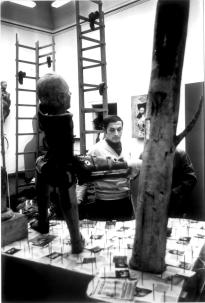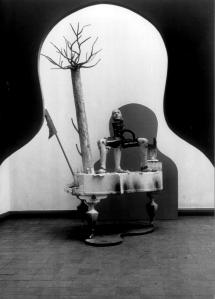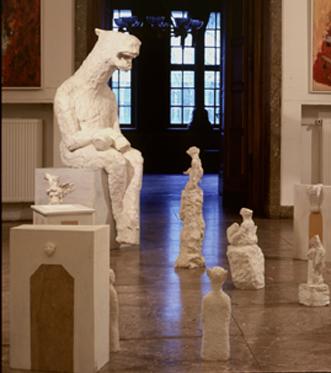Exhibition arranged by Emilia Wedrowska at the old Zamek Castle in the centre of Poznan for the Danish Culture Institute represented by the following 8 Danish artists: Doris Bloom, Nils Erik Gjerdevik, Henrik Have, Bentemarie Kjeldbæk, Lise Malinovsky, Anne Tholstrup, Anne Vilsbøll and Pontus Kjerrman. The exhibition was later moved to the state library in Warszawa. On the opening Pontus Kjerrman held the following speech:
Fragments of a story – to Hasior and Josef Szajna
I have made an installation that consists of 20 parts all except one made in plaster. There are many ways to define an installation; for me it is essential that the figures be placed on the floor. When you place a figure on a socle or a base, it creates a world of its own, but when it stands on the floor it becomes a player in the room the same way as the spectators entering the room become players.
I called this installation a homage to Hasior and Josef Szajna (JS). 30 years ago I saw a very pushing, aggressive installation at a Polish exhibition at the Art Museum of Göteborg, Sweden. Josef Szajna had populated the installation with dummies from shop windows, though partly destroyed they were draped in dirty old cloth, ropes and garbage.


The floor was covered with shoes and earth; a partly destroyed almost buried dummy was lying in between. One of the standing figures represented the goddess of victory, Nike, with half her face damaged and the other half smiling. On a piano was a head, symbolizing Chopin, mounted on three artificial legs, and as a whole it represented a spider-like creature. Furthermore on the piano photographs were nailed of Polish artists who had died in concentration camp. When 11 years later I came to Copenhagen to study art and came to know a lot of new art, I recalled the installation of Josef Szajna. On a visit to Göteborg I decided to ask for press photographs taken at the exhibition. I succeeded to collect material that described almost every corner of Szajna¹s installation. Among them one where Szajna himself on the opening lighted a candle placed between shoes, earth, the corps and photographs of concentration camp prisoners. When I say that Szajna¹s art has a big impact on me, it does not mean that I just copy it. I do not have the same background as Szajna who already at 17 was imprisoned because of contacts with the resistance movement, which no doubt had a great impact on his art. I had a secure childhood in Sweden. So in that sense I do not have the background of experiences as Szajna, but I feel that Szajna¹s work is universal, and I would like to express the same feelings on the background of my own experiences. Some years later I saw an exhibition by Hasior in which he had filled some big rooms with long flags from the floor to the ceiling and baby carriages full of earth and burning candles. Materials like these have a strong emotional meaning in themselves and could easily make art superficial. However, with their seriousness and professionalism Hasior and Josef Szajna give them a truthful and strong expression. In 1989 I represented Denmark with an installation at the Biennial of Sao Paolo. Here I met Josef Szajna who represented Poland with an installation in many ways similar to the one in Göteborg. He was very pleased with my interest for his exhibition in Göteborg, and I promised to send copies of the photos I had collected. I later received catalogues about his work at theatres, and hereby I realized that his work is neither solely visual art nor theatre, but a mixture of the two, and that is what makes it so special.
Pontus Kjerrman
March 2000
